Post and Rail Fencing Costs, Calculator & Free Quotes
Last Updated on By Jon
From fencing in livestock to marking boundaries a post and rail fence is a popular, attractive and functional choice of fence work for both agricultural, equestrian and residential properties.
Our free 2025 guide to post and rail fencing costs will provide you with all the information you need to undertake your next fencing project for less.
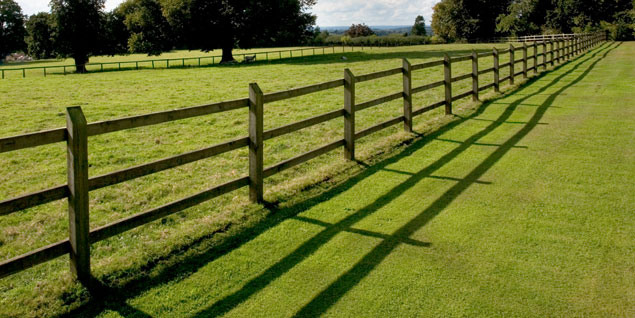
Average post and rail fencing costs
With several variations to choose from, here are some average prices:
Average Fence Post Costs | ||||
| Length | Type | Mortise? | Style | Av. Price |
| 1.8m | Inter Post | 3 | Sawn | £24.25 |
| 1.8m | Inter Post | 3 | Cleft Chestnut | £21.34 |
| 1.8m | Inter Post | 2 | Sawn | £21.34 |
| 1.8m | Inter Post | 2 | Cleft Chestnut | £19.89 |
| 1.8m | Inter Post | 0 | Round | £6.11 |
| 1.2m | Birdsmouth | 0 | Planed | £16.20 |
| 0.9m | Birdsmouth | 0 | Planed | £12.32 |
| 1.8m | Corner Post | 3 | Sawn | £24.25 |
| 1.5m | Prick Post | 0 | Sawn | £8.25 |
Average Fence Rail Costs | ||||
| Length | Type | Av. Price | ||
| 3m | Square Section | £15.52 | ||
| 3m | Cleft Chestnut | £15.04 | ||
| 3.6m | Half-round | £9.31 | ||
| 2.4m | Birdsmouth | £8.05 | ||
Additional Costs | ||||
| Item | Av. Price | |||
| Postcrete per bag | £6.16 | |||
| 90x90cm Garden Gate | £121.25 | |||
| Post Digger | £38.80 | |||
| Nails & Fixings (per bag) | £6.31 | |||
(Prices taken from multiple sources and averaged) Prices Checked 27/06/2025 |
||||
Post and Rail Fencing Cost Calculator
Factors affecting the cost of your post and rail fence
As with most fencing projects there will likely be additional costs that will need to be factored in to the overall project budget. Here are a few to consider:
- Style of fence: Whether your fence is machined half-round, sawn or cleft the prices will vary according to the style and material used.
- Length of fence: It goes without saying that the longer the fence, the more posts and rails you will need which will increase the price accordingly.
- Wood Treatment: While posts and rails are frequently treated with wood preservative, some prefer to treat their fence themselves or even not at all when using hardwood.
- Gates and access: You will likely need access to the area that you are fencing off which is where a new gate (and gate posts) will come in and increase the price accordingly.
- Wire: Post and rail fencing is great for demarcation and for larger livestock, but you may need some wire mesh stapled to the posts if you want to stop smaller animals entering or leaving your area.
- Fixings: If you're installing your fence yourself you will need to budget for fixings such as nails, screws, staples and specialist straps for knee rail style fencing.
- Postcrete/concrete: Though it's perfectly fine to install fence posts directly into suitable ground, if it is too soft you may want to factor in the cost of Postcrete or standard concrete for additional post support.
What is Post and Rail Fencing?
The term 'post and rail fencing' covers several styles of fence which all share the same characteristic: they are made up of a series of (usually solid timber) posts with horizontal rails secured between the posts.
This type of fencing is typically used as a cost-effective way to form a strong perimeter around property boundaries, farmland and for the enclosure of livestock.
It forms a strong protective barrier, however the open style allows for unrestricted views making it popular in both agricultural and residential settings.
Types of post and rail fencing
There are typically 5 types of post and rail fencing that are commonly used throughout the UK:
- Machined half-round
- Square cut
- Chestnut cleft also known as Sussex rail
- Lincolnshire fencing
- Knee rail / diamond wood / birdsmouth
Morticed fence posts
Though there are many different styles and materials that fall under the category of post and rail fencing, fence posts will typically fall under morticed or whole.
In contrast to whole posts where the rails are simply nailed or screwed on, mortised posts have recesses carved into them in which the rails are slotted. This can be advantageous when it comes to following the contours of uneven land as it forms a contoured fence at a uniform height (assuming the posts are all set at the same depth).
Each post can have as many as five rows of mortices (arranged in horizontal pairs) so that the rails can be fully inserted for maximum stability.
Get Free Post & Rail Fence Quotes OnlineChestnut cleft post and rail fencing
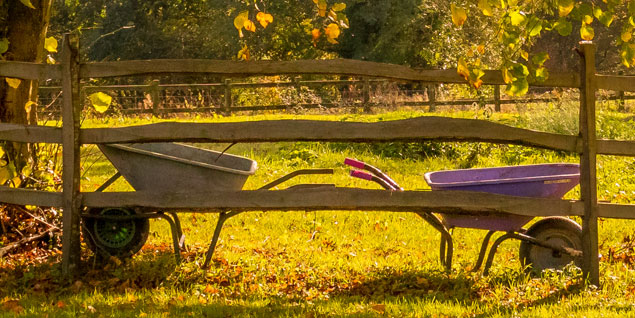
Sometimes referred to as Sussex Rail, Chestnut cleft fencing is perhaps the most rustic-looking of the post and rail options. Chestnut is a hardwood and as such creates a durable fence which won't need to be treated to provide a long-life.
The rails are formed by splitting chestnut logs along the grain and typically come in either 9ft or 6ft lengths. They are hand-carved to form the tenons which allow them to fit into a chestnut post mortise.
The chestnut posts themselves are normally half-round logs and feature both bark and a natural shape adding to the rustic nature.
When installing the rails, it is commonplace for the cut/exposed side to face up. This means that unless processed further by sanding they are unsuitable to be used as handrails due to possible splintering.
Square cut post and rail fencing
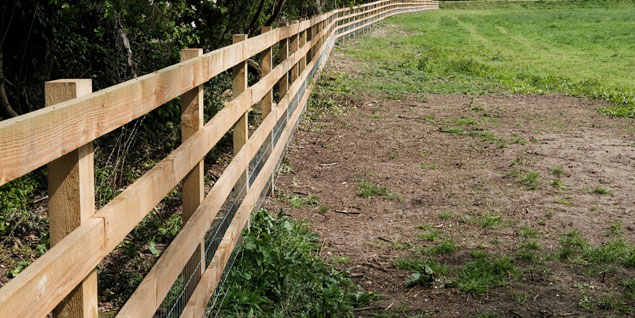
Cleaner looking, and simpler to construct square cut post and rail fencing is as it sounds... timber that is cut ay 90-degree angles typically into square profile posts and rectangular profile rails.
The construction process is a simple one, with posts being set into the ground at measured intervals (typically 180cm), then rails simply nailed or screwed onto them in continuous rows. With longer spans up to 360cm, smaller profile intermediate posts called pricker posts can be simply dug in and nailed to the rails to strengthen the overall span and reduce any bowing.
It's worth noting that square-cut posts can also be morticed so that the rectangular profile rails can simply be slotted in place. They can even be pointed at the ground end for easy driving using a post rammer or machine.
Half round post and rail fencing
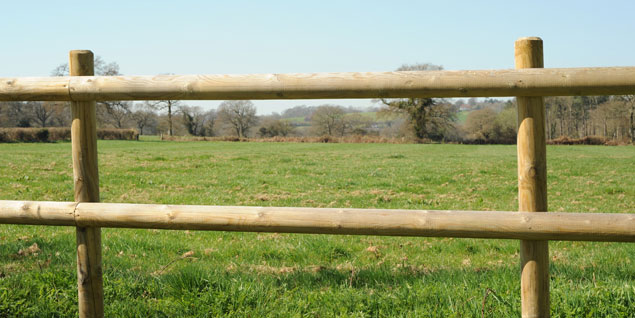
Constructed in the same way as square cut fences, as the name suggests this style of fencing uses half-round profile rails which are typically attached to round-profile posts (though the posts can also be half-round profiles).
The overall effect is a softer more rustic looking fence that is both cost-effective and easy to install.
Knee rail or birdsmouth fencing
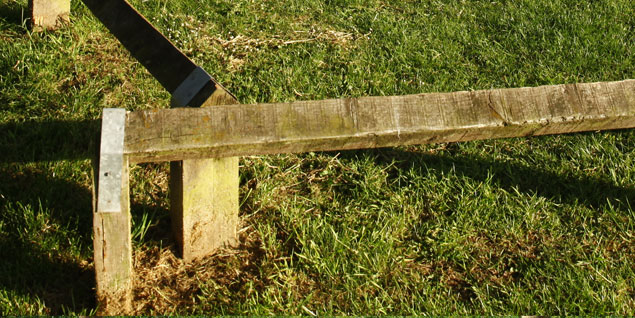
You may have seen this low style of post and rail fence in public parks, walkways or even carparks.
It is typically used to protect flowerbeds or lawned areas to deter foot traffic.
The name 'birdsmouth' arises from the notch cut out ot the top of the fence post, which allows for a suitably sized square-profile rail (typically 100mm x 100mm profile) to be placed and secured with ease. It looks like an open bird's mouth looking to be fed!
Once in place, the rail is strapped to the post to create a very strong boundary.
Lincolnshire fencing
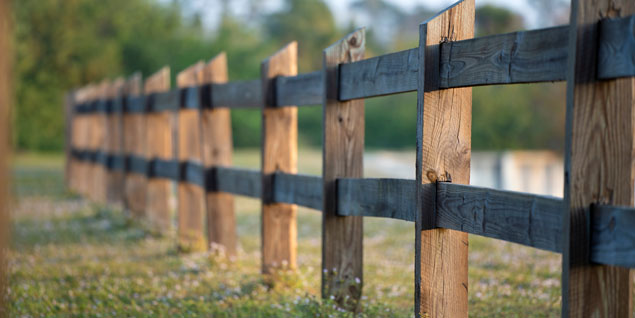
If you would like a mix of both straight cut and morticed fencing, then Lincolnshire fencing is the answer.
Though it uses straight cuts, the posts are morticed, and the rails are chamfered at both ends for insertion.
Where it differs from other mortise and tenon applications, is that a continuous run of rails uses the same mortise holes, with the chamfered ends meeting inside the mortise hole to form a tight continuous join. This makes for a very sturdy fence with dissipates any pressure put on it (such as animals leaning) along the entirety of the fence.
Where can I install post and rail fencing?
Post and rail is one of the most diverse types of fencing ad lends itself to many different applications:
- Agricultural / Livestock / Equestrian - When used in 3-5 rail heights it can be perfect to keep animals in and people out. It is strong fence but doesn't dominate the landscape as it lets lots of light and views through.
- Cottage / Rustic - When used at a 2-bar height of around 90cm, post and rail can be the perfect fence to mark out cottage gardens. If you're looking for a rustic look then there isn't much better than cleft chestnut fencing.
- Urban - In any height, a clean square cut or machined half-round fence can suit almost any style building. They can be painted to match any colour scheme.
How to guide - erecting a post and rail fence
The process of erecting a post and rail fence is very straightforward, here are the main steps (please note for morticed posts the process differs slightly as explained below):
1. Digging the post holes
Depending on the width of the rails being used, your posts holes should be dug accordingly. Typically, this is at 6ft centres. You should make the hole deep enought to take a third of the height of the pole plus a few inches of gravel for drainage. THe hole should also be at least twice the width of the post in diameter.
Digging the holes can be done manually, with a post-hole digger or even a post-hole drill.
2. Inserting and levelling the posts
Once inserted into the hole, and confirmed to be at the right height you can level the posts and start to backfill. If you have 2 spirit levels, you can simply tape them to adjoining faces to check level in both directions.
If using Poscrete or concrete, you may wish to use 2 lengths of wood to brace the post in position while it sets.
3. Backfilling the hole
Once level, start to infill and tamp with the tailings from the hole.
If you are using concrete then follow the instructions to fill the hole, tamp it down and leave the post to set for the recommended timeframe.
4. Adding the rails
With your posts now set and level they are ready to receive the rails. Using galvanized nails or screws they are simply attached to the centre of the posts to form a continuous run. The rails should be equally spaced, however be sure to leave a suitable gap from the floor to help avoid rot and increase the convenience of being able to strim/mow grass underneath them.
* A note on morticed posts
It's worth noting that the process differs slightly when using morticed posts. If you were to set your posts in first, there would be no way to slide the rails with tenons into place.
Therefore, each post must have its rails in place before being secured into the ground.
Frequently Asked Questions
What height should my post and rail fence be?
There are 2 standard heights for post and rail fences:
- 4ft (120cm) - enough for 3 rails and typically used as livestock fencing and barrier fencing. A more substantial fence used to prevent access.
- 3ft (90cm) - used with 2 rails and perfect for garden demarcation where larger animals are not being contained. Suitable for all house types from new to rustic.
How deep should the fence posts be buried?
The general rule where possible is that fence posts should be buried to a depth of a third of their height. For instance, if you have a 180cm post you should try to bury it 60cm. The diameter of the hole should also be at least twice the width of the post. You should also try to allow an inch or two for a gravel bed at the base of the hole.
What height posts should I use?
If you're constructing a 3-rail fence then your post will likely be 210cm or 7ft tall to allow for suitable depth. For a smaller 2 rail fence a 180cm or 6ft post will be suitable.
Should you concrete in the posts?
If your ground is suitable for compaction, your posts are pointed, and the posts can be inserted directly using a post rammer or machine then you don't need to use concrete. If however your ground consists of a loose material, or you need extra support on the posts then it is advisable to use concrete or one of the fast setting brands such as Postcrete which sets in as little as 15 minutes.
It's worth noting that if you are containing larger livestock, not using concrete will add a little flexibility into the fence if it is leaned upon.
Do you place gravel in the post hole?
It's always advisable to add a small layer of gravel or pea grit into the bottom of your newly dug post hole. This helps with drainage, keeping the cut end (which is the most absorbent) out of contact with any standing water in the hole.
How do I attach rails to posts?
If you're not using morticed posts, then the most straightforward way to attach your rails to your posts is the use of galvanized nails or screws that are both long enough for a secure fixing, and weatherproof to ensure longevity.
For Knee rail or birsdmouth fencing you will use specialist plate fixings which wrap around the rail and are nailed or screwed into place on the post.
Should the rails follow the contours of the ground?
Yes. To achieve a consistent height, fence you should install the posts at the correct depth according to the ground level and attach the rails at the same point on each post. This will ensure you have the maximum height fence at all times and will look neater overall.
Compare Fencing Specialists Now